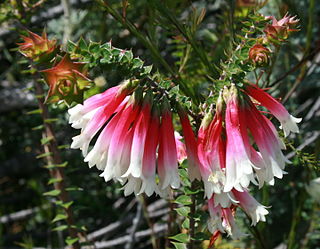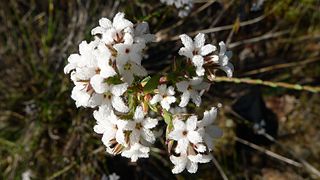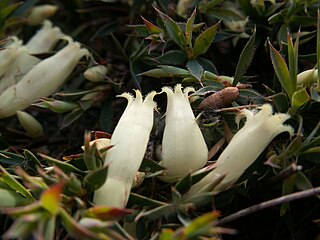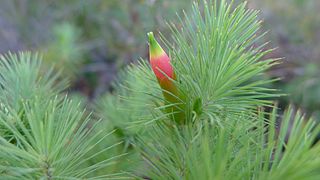
Angophora is a genus of nine species of trees and shrubs in the myrtle family, Myrtaceae. Endemic to eastern Australia, they differ from other eucalypts in having juvenile and adult leaves arranged in opposite pairs, sepals reduced to projections on the edge of the floral cup, four or five overlapping, more or less round petals, and a papery or thin, woody, often strongly ribbed capsule. Species are found between the Atherton Tableland in Queensland and south through New South Wales to eastern Victoria, Australia.
Astroloma is a historically recognised genus of about 25 species of flowering plants in the family Ericaceae and endemic to Australia.

Woollsia is a monotypic genus in the family Ericaceae. The sole species, Woollsia pungens, known as snow heath, is a small shrub found in eastern Australia, from Pigeon House Mountain in southern New South Wales north into Queensland.

Epacris longiflora, commonly known as fuchsia heath or cigarette flower, is a plant in the family Ericaceae and is endemic to eastern Australia. It is an erect or spreading shrub with egg-shaped, pointed leaves and red tube-shaped flowers which give the plant its name longiflora and are usually present throughout the year. Its native range extends from the central coast of New South Wales to southern Queensland.

Bursaria spinosa is a small tree or shrub in the family Pittosporaceae. The species occurs mainly in the eastern and southern half of Australia and not in Western Australia or the Northern Territory. Reaching 10 m (35 ft) high, it bears fragrant white flowers at any time of year but particularly in summer. A common understorey shrub of eucalyptus woodland, it colonises disturbed areas and fallow farmland. It is an important food plant for several species of butterflies and moths, particularly those of the genus Paralucia, and native bees.

Kunzea ambigua, commonly known as white kunzea, poverty bush or tick bush, is a plant in the myrtle family, Myrtaceae and is found mainly on sandstone soils in eastern Australia. Growing up to 5 m (16 ft) high and wide, it bears small white flowers in spring. Used in native gardening, it attracts native insects. It is also used in amenities planting and sand dune stabilization.

Isopogon ceratophyllus, commonly known as the horny cone-bush or wild Irishman, is a plant of the family Proteaceae that is endemic to the coast in Victoria, South Australia and on the Furneaux Group of islands in Tasmania. It is a small woody shrub that grows to 100 cm high with prickly foliage. It is extremely sensitive to dieback from the pathogen Phytophthora cinnamomi

Astroloma pinifolium, commonly known as pine heath, is small prostrate shrub or groundcover in the family Ericaceae endemic to eastern Australia.

Persoonia levis, commonly known as the broad-leaved geebung, is a shrub native to New South Wales and Victoria in eastern Australia. It reaches 5 m (16 ft) in height and has dark grey papery bark and bright green asymmetrical sickle-shaped leaves up to 14 cm (5.5 in) long and 8 cm (3.2 in) wide. The small yellow flowers appear in summer and autumn, followed by small green fleshy fruit, which are classified as drupes. Within the genus Persoonia, it is a member of the Lanceolata group of 58 closely related species. P. levis interbreeds with several other species where they grow together.

Epacris pulchella, commonly known as wallum heath or coral heath is a species of flowering plant in the family Ericaceae and is endemic to eastern Australia. It is a slender, erect shrub with egg-shaped, pointed leaves and white or pinkish, tube-shaped flowers.

Styphelia adscendens, commonly known as golden heath, is a species of flowering plant in the heath family Ericaceae and is endemic to south-eastern Australia. It is a prostrate or low-lying shrub with lance-shaped leaves and cream-coloured, pale yellowish-green or reddish flowers arranged singly or in paris in leaf axils.

Leucopogon juniperinus, commonly known as prickly beard-heath, is a species of flowering plant in the heath family Ericaceae and is endemic to south-eastern continental Australia. It is an erect, densely-branched shrub with oblong to more or less egg-shaped leaves with the narrower end towards the base, and white, tube-shaped flowers arranged singly in upper leaf axils.

Leucopogon ericoides, commonly known as the pink beard-heath, is a species of flowering plant in the heath family Ericaceae and is endemic to south-eastern Australia. It is a slender shrub with oblong leaves, and white to pinkish, tube-shaped flowers.

Leucopogon amplexicaulis, commonly known as beard-heath, is a species of flowering plant in the heath family Ericaceae and is endemic to eastern New South Wales. It is a scrambling or straggly shrub with egg-shaped, stem-clasping leaves with hairy edges, and spikes of small white flowers.

Leucopogon microphyllus is a species of flowering plant in the heath family Ericaceae and is endemic to eastern Australia. It is a bushy or spreading shrub with egg-shaped leaves, sometimes with the narrower end towards the base, and compact spikes of usually four to nine white, tube-shaped flowers.
Dipodium campanulatum, commonly known as the bell-flower hyacinth orchid, is a leafless mycoheterotroph orchid that is endemic to south-eastern Australia. In summer it has up to thirty five white flowers with large, dark red spots and blotches.

Stenanthera is a genus of flowering plants in the family Ericaceae. Most are low shrubs with leaves that are paler on the lower surface, tube-shaped flowers and with the fruit a drupe. There are three species, formerly included in the genus Astroloma.

Styphelia pallida, commonly known as kick bush, is usually a small, compact shrub in the family Ericaceae. The species is endemic to south-western Western Australia.

Stenanthera pinifolia, commonly known as pine heath, is a species flowering plant in the family Ericaceae. It is a of shrub that is endemic to south-eastern Australia. It has narrow, linear leaves, yellow or red tubular flowers and a small edible berry.

Leucopogon collinus, commonly known as fringed beard-heath, is a species of flowering plant in the heath family Ericaceae and is endemic to south-eastern Australia. It is a slender, erect or spreading shrub with narrowly lance-shaped leaves, and white, tube-shaped, bearded flowers.


















